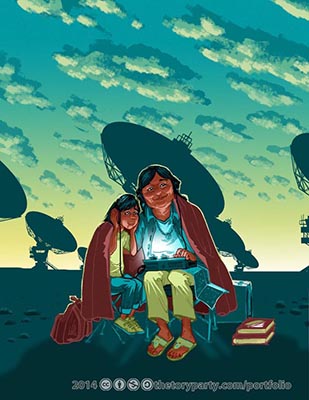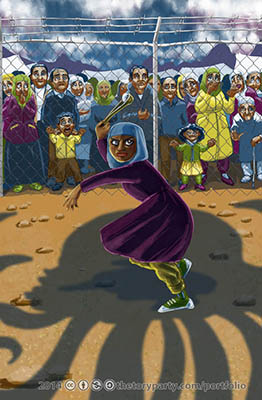
APEX MAGAZINE: Can you tell us a little bit about yourself as an illustrator?
TORY HOKE: Sure. I showed aptitude early and got encouraged. My heart goes out to anybody who likes to draw and never got that encouragement. Drawing is fun as hell, practice pays, and anyone can do it. People just get self-conscious when they’re older.
Also my dad got me hooked on MAD Magazine. Reading and studying and trying to copy the drawings—oh man, the stuff I cribbed. Mort Drucker’s loop-de-loop little kid noses. Sam Viviano’s radially-shaded wrists. Sergio Aragones’s mouths-running-off-the-face. If you want to cartoon, MAD’s a master course on the cheap.
But mostly I had time to kill. You know how George R. R. Martin said ASOIAF started as stories he made up about pet turtles he kept as a kid? I think most creatives are like that—for whatever reason, growing up they spent a lot of time alone, romping around their brainspace, building up their Headcanon of Alexandria. Drawing, writing, modeling, animating, making movies—it’s all just a way to get the stories out, you know, and hope to God you get someone else to look at it.
Speaking of—my Rare Words vocabulary comic updates weekdays on my [blog](www.thetoryparty.com), [Twitter](www.twitter.com/toryhoke), and [Tumblr](vocabularycomics.tumblr.com). It’s a great resource for browsing a bunch of words you will never, ever use.
AM: Your piece ‘Bleef’ seems to have a great combination of sweetness, combined with a deeper concept. What was your inspiration behind this piece?
TH: Thank you. I think what happened is I’d just finished “Guardian,” which is a woman sort of standing there not doing anything—it’s cool, I’m not mad at it, but she’s not doing anything—and I was like, “Uh, let’s tell a little more story next time.” And I got this image of a little girl leading a monster by a ribbon, with the monster thinking, “This is the best thing that ever happened to me.” Because a monster’s what you make it.
AM: Looking through your website I noticed a lot of artwork that are editorially evocative and possibly have social commentary. What sorts of messages are you intending to achieve as an artist? How do you come up with your ideas for your artwork?
TH: That’s encouraging of you to say. I’m glad those ideas are coming across. Generally there’s one thought that kicks things off, like, “If this blog saw my portfolio, I’d be embarrassed” or “Man, I’ve had it with the ‘sexy fairy girl’ trope.” Then the image comes pretty quickly and I try not to screw it up.
I like to show kids sticking it to authority. Every kid is going to run into an adult who doesn’t have their best interests at heart, who’s happy to belittle and dismiss and manipulate the kid: “You’re too sensitive,” “That didn’t hurt,” “There’s something wrong with you.” Every kid should be encouraged to listen to their gut. Keep looking for help. Get safe. If kids see pictures of that in their world, maybe it’ll help.
Mostly I hope my work says “Come on over. We saved you a spot.”
AM: You also have a lot of different branches from illustration to set design to comics and sequential art. Do you have any preferences to which art you enjoy creating? Do you think creating 2D art digitally can translate into creating sets and 3D models, or vice versa?
TH: You probably know how it is—at the outset of a project, there’s that question of “What’s the best way to get this story out?” After that, the only consideration is time. I love drawing comics, love it so hard, but good God, time-wise that’s gotta be the highest creation-to-consumption ratio there is. Pick up Craig Thompson’s Blankets, ten pounds of art, and you gotta ask, “How did he stay that focused that long? How did he keep his style consistent? How did he keep from cutting corners?” I have no idea.
A single color illustration is a blast because it takes a day and a half to finish. But a successful comic gives the reader a deep ineffable feeling that stays and stays and stays. And Blankets is a prime example of that.
By contrast, I’d say working in film is all communication and problem-solving and teamwork and a bunch of stuff you don’t have to deal with when you’re Henry-Darger-ing it up at your desk. The emotional satisfaction comes from getting the shot before the kid actor has to wrap, or realizing you can swap out that scuffed linoleum tile instead of trying to fix it. It comes from pulling off a huge caper with your department like you’re Ocean’s 11 with a screwgun. If you helped make a movie that gives people a feeling, great, but it’s not necessarily your driving force.
AM: There is a range of people and subject matter in your art that I think engages and speaks to many different communities. What sorts of artistic and conceptual goals do you set for yourself when you illustrate?
TH: Heh. Mostly I’m trying to minimize my future shame. As long as I’m out there promoting myself, taking up bandwidth, I have a responsibility to make my body of work reflect the people who are stuck looking at it. I’ve got a long way to go, but my portfolio is at least 20% less embarrassing than it used to be.
I’m grateful for the luxury of drawing what I want, for my own amusement—so I’ve got plenty of opportunity to take off the next set of blinders and ask, “Who doesn’t have a spot saved?”
AM: How would you describe your sense of artistic style? How do you feel about your current style?
TH: Hmm. Sergio Aragones wannabe? That’s pretty lofty. I dunno. My stuff is kind of pervasively silly. I try to do serious, but then I feel bad for the characters. So I try to lighten it up, cut ’em a break.
I’m trying to develop a more sculptural, less line-y style option—something more serious. But it’s not my strong suit. The silly keeps sneaking back in.
AM: What do you love about creating artwork in the genres of fantasy, horror and science fiction? Any advice for aspiring comic book and illustration artists?
TH: You can’t beat the freedom of telling whatever story you want, whatever way you want. I’m grateful to be working in an age where there are so many ways for art and eyeballs to find each other. You can connect. You can show people your weird little dream. Maybe it’ll resonate. Maybe you can join their weird little dream.
To anyone else making stuff or thinking about making stuff—drawing, writing, whatever—just go for it. Do it. Fail early and often. Fall down seven times, stand up eight. Find the process that finds your weakness. Put your stuff in front of other people. Embarrass yourself. Find out it’s not fatal.
Oh, and seek out a day job in technology. Holy cats, yes, a day job in technology.
AM: Thank you very much for letting Apex Magazine feature your beautiful artwork! Best of luck in your future artistic ventures.
TH: Thank you so much for having me, Loraine. It’s been an honor and a treat. Keep up the good work.











